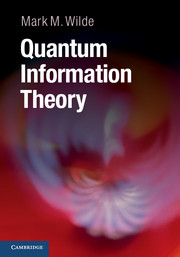Book contents
- Frontmatter
- Contents
- How To Use This Book
- Acknowledgments
- Part I Introduction
- Part II The Quantum Theory
- Part III Unit Quantum Protocols
- Part IV Tools of Quantum Shannon Theory
- 9 Distance Measures
- 10 Classical Information and Entropy
- 11 Quantum Information and Entropy
- 12 The Information of Quantum Channels
- 13 Classical Typicality
- 14 Quantum Typicality
- 15 The Packing Lemma
- 16 The Covering Lemma
- Part V Noiseless Quantum Shannon Theory
- Part VI Noisy Quantum Shannon Theory
- Appendix A Miscellaneous Mathematics
- Appendix B Monotonicity of Quantum Relative Entropy
- References
- Index
16 - The Covering Lemma
from Part IV - Tools of Quantum Shannon Theory
Published online by Cambridge University Press: 05 May 2013
- Frontmatter
- Contents
- How To Use This Book
- Acknowledgments
- Part I Introduction
- Part II The Quantum Theory
- Part III Unit Quantum Protocols
- Part IV Tools of Quantum Shannon Theory
- 9 Distance Measures
- 10 Classical Information and Entropy
- 11 Quantum Information and Entropy
- 12 The Information of Quantum Channels
- 13 Classical Typicality
- 14 Quantum Typicality
- 15 The Packing Lemma
- 16 The Covering Lemma
- Part V Noiseless Quantum Shannon Theory
- Part VI Noisy Quantum Shannon Theory
- Appendix A Miscellaneous Mathematics
- Appendix B Monotonicity of Quantum Relative Entropy
- References
- Index
Summary
The goal of the covering lemma is perhaps opposite to that of the packing lemma because it applies in a setting where one party wishes to make messages indistinguishable to another party (instead of trying to make them distinguishable as in the packing lemma of the previous chapter). That is, the covering lemma is helpful when one party is trying to simulate a noisy channel to another party, rather than trying to simulate a noiseless channel. One party can accomplish this task by randomly covering the Hilbert space of the other party (this viewpoint gives the covering lemma its name).
One can certainly simulate noise by choosing a quantum state uniformly at random from a large set of quantum states and passing along the chosen quantum state to a third party without telling which state was chosen. But the problem with this approach is that it could potentially be expensive if the set from which we choose a random state is large, and we would really like to use as few resources as possible in order to simulate noise. That is, we would like the set from which we choose a quantum state uniformly at random to be as small as possible when simulating noise. The covering lemma is similar to the packing lemma in the sense that its conditions for application are general (involving bounds on projectors and an ensemble), but it gives an asymptotically efficient scheme for simulating noise when we apply it in an IID setting.
- Type
- Chapter
- Information
- Quantum Information Theory , pp. 401 - 414Publisher: Cambridge University PressPrint publication year: 2013

